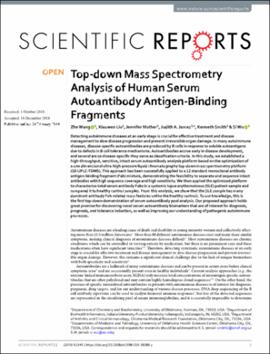| dc.contributor.author | Wang, Zhe | |
| dc.contributor.author | Liu, Xiaowen | |
| dc.contributor.author | Muther, Jennifer | |
| dc.contributor.author | James, Judith A. | |
| dc.contributor.author | Smith, Kenneth | |
| dc.contributor.author | Wu, Si | |
| dc.date.accessioned | 2019-04-02T19:17:25Z | |
| dc.date.available | 2019-04-02T19:17:25Z | |
| dc.date.issued | 2019-02-20 | |
| dc.identifier.citation | Wang, Zhe. Liu, Xiaowen. Muther, Jennifer. James, Judith A. Smith, Kenneth. Wu, Si. (2019). Top-down Mass Spectrometry Analysis of Human Serum Autoantibody Antigen-Binding Fragments. Scientific Reports, 9(2345). | en_US |
| dc.identifier.uri | https://hdl.handle.net/11244/317834 | |
| dc.description.abstract | Detecting autoimmune diseases at an early stage is crucial for effective treatment and disease management to slow disease progression and prevent irreversible organ damage. In many autoimmune diseases, disease-specific autoantibodies are produced by B cells in response to soluble autoantigens due to defects in B cell tolerance mechanisms. Autoantibodies accrue early in disease development, and several are so disease-specific they serve as classification criteria. In this study, we established a high-throughput, sensitive, intact serum autoantibody analysis platform based on the optimization of a one dimensional ultra-high-pressure liquid chromatography top-down mass spectrometry platform (1D UPLC-TDMS). This approach has been successfully applied to a 12 standard monoclonal antibody antigen-binding fragment (Fab) mixture, demonstrating the feasibility to separate and sequence intact antibodies with high sequence coverage and high sensitivity. We then applied the optimized platform to characterize total serum antibody Fabs in a systemic lupus erythematosus (SLE) patient sample and compared it to healthy control samples. From this analysis, we show that the SLE sample has many dominant antibody Fab-related mass features unlike the healthy controls. To our knowledge, this is the first top-down demonstration of serum autoantibody pool analysis. Our proposed approach holds great promise for discovering novel serum autoantibody biomarkers that are of interest for diagnosis, prognosis, and tolerance induction, as well as improving our understanding of pathogenic autoimmune processes. | en_US |
| dc.description.sponsorship | S.W., J.J., K.S., and X.L. provided funding; K.S. and J.M. prepared antibody and serum autoantibody samples; Z.W. and S.W. performed MS and LC experiments; Z.W., S.W., and X.L. performed data analysis; Z.W., X.L., J.J., K.S., and S.W. wrote the manuscript.
Open access fees fees for this article provided whole or in part by OU Libraries Open Access Fund. | en_US |
| dc.language | en_US | en_US |
| dc.rights | Attribution 4.0 International | * |
| dc.rights.uri | https://creativecommons.org/licenses/by/4.0/ | * |
| dc.subject | Proteomics | en_US |
| dc.subject | Systemic lupus erythematosus | en_US |
| dc.title | Top-down Mass Spectrometry Analysis of Human Serum Autoantibody Antigen-Binding Fragments | en_US |
| dc.type | Article | en_US |
| dc.description.peerreview | Yes | en_US |
| dc.identifier.doi | 10.1038/s41598-018-38380-y | en_US |
| ou.group | College of Arts and Sciences::Department of Chemistry and Biochemistry | en_US |

